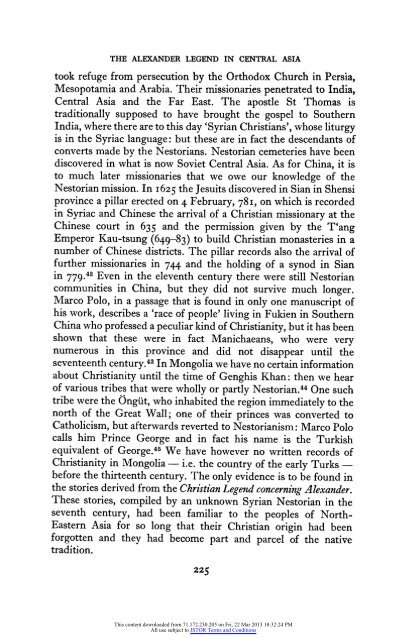The Alexander Legend in Central Asia
The Alexander Legend in Central Asia
The Alexander Legend in Central Asia
You also want an ePaper? Increase the reach of your titles
YUMPU automatically turns print PDFs into web optimized ePapers that Google loves.
THE ALEXANDER LEGEND IN CENTRAL ASIA<br />
took refuge from persecution by the Orthodox Church <strong>in</strong> Persia,<br />
Mesopotamia and Arabia. <strong>The</strong>ir missionaries penetrated to India,<br />
<strong>Central</strong> <strong>Asia</strong> and the Far East. <strong>The</strong> apostle St Thomas is<br />
traditionally supposed to have brought the gospel to Southern<br />
India, where there are to this day 'Syrian Christians', whose liturgy<br />
is <strong>in</strong> the Syriac language: but these are <strong>in</strong> fact the descendants of<br />
converts made by the Nestorians. Nestorian cemeteries have been<br />
discovered <strong>in</strong> what is now Soviet <strong>Central</strong> <strong>Asia</strong>. As for Ch<strong>in</strong>a, it is<br />
to much later missionaries that we owe our knowledge of the<br />
Nestorian mission. In 1625 the Jesuits discovered <strong>in</strong> Sian <strong>in</strong> Shensi<br />
prov<strong>in</strong>ce a pillar erected on 4 February, 781, on which is recorded<br />
<strong>in</strong> Syriac and Ch<strong>in</strong>ese the arrival of a Christian missionary at the<br />
Ch<strong>in</strong>ese court <strong>in</strong> 635 and the permission given by the T'ang<br />
Emperor Kau-tsung (649-83) to build Christian monasteries <strong>in</strong> a<br />
number of Ch<strong>in</strong>ese districts. <strong>The</strong> pillar records also the arrival of<br />
further missionaries <strong>in</strong> 744 and the hold<strong>in</strong>g of a synod <strong>in</strong> Sian<br />
<strong>in</strong> 779.42 Even <strong>in</strong> the eleventh century there were still Nestorian<br />
communities <strong>in</strong> Ch<strong>in</strong>a, but they did not survive much longer.<br />
Marco Polo, <strong>in</strong> a passage that is found <strong>in</strong> only one manuscript of<br />
his work, describes a 'race of people' liv<strong>in</strong>g <strong>in</strong> Fukien <strong>in</strong> Southern<br />
Ch<strong>in</strong>a who professed a peculiar k<strong>in</strong>d of Christianity, but it has been<br />
shown that these were <strong>in</strong> fact Manichaeans, who were very<br />
numerous <strong>in</strong> this prov<strong>in</strong>ce and did not disappear until the<br />
seventeenth century.43 In Mongolia we have no certa<strong>in</strong> <strong>in</strong>formation<br />
about Christianity until the time of Genghis Khan: then we hear<br />
of various tribes that were wholly or partly Nestorian.44 One such<br />
tribe were the 0ngiit, who <strong>in</strong>habited the region immediately to the<br />
north of the Great Wall; one of their pr<strong>in</strong>ces was converted to<br />
Catholicism, but afterwards reverted to Nestorianism: Marco Polo<br />
calls him Pr<strong>in</strong>ce George and <strong>in</strong> fact his name is the Turkish<br />
equivalent of George.45 We have however no written records of<br />
Christianity <strong>in</strong> Mongolia - i.e. the country of the early Turks -<br />
before the thirteenth century. <strong>The</strong> only evidence is to be found <strong>in</strong><br />
the stories derived from the Christian <strong>Legend</strong> concern<strong>in</strong>g <strong>Alexander</strong>.<br />
<strong>The</strong>se stories, compiled by an unknown Syrian Nestorian <strong>in</strong> the<br />
seventh century, had been familiar to the peoples of North-<br />
Eastern <strong>Asia</strong> for so long that their Christian orig<strong>in</strong> had been<br />
forgotten and they had become part and parcel of the native<br />
tradition.<br />
225<br />
This content downloaded from 71.172.230.205 on Fri, 22 Mar 2013 18:32:24 PM<br />
All use subject to JSTOR Terms and Conditions
















